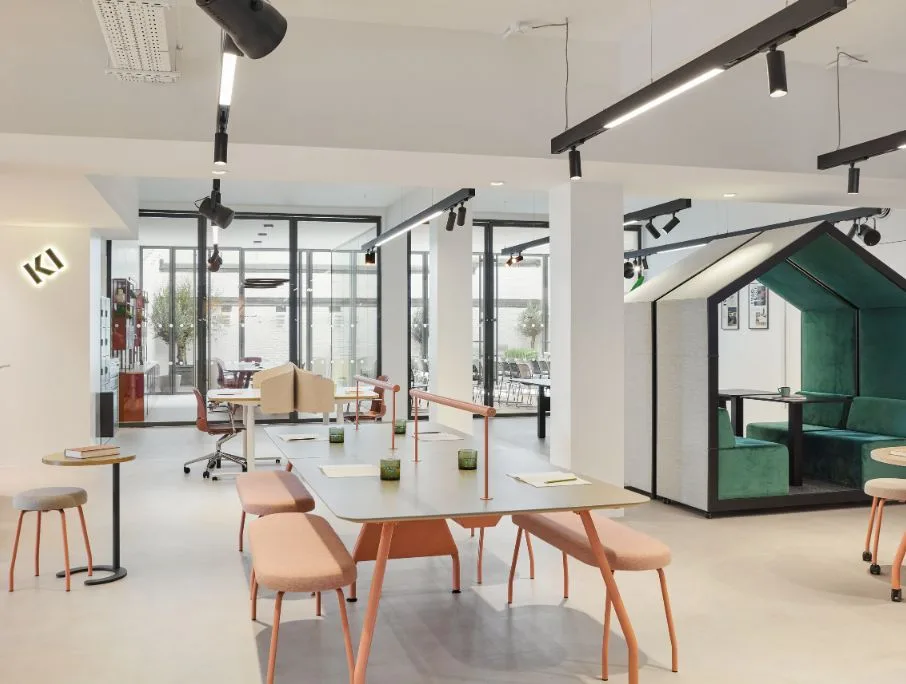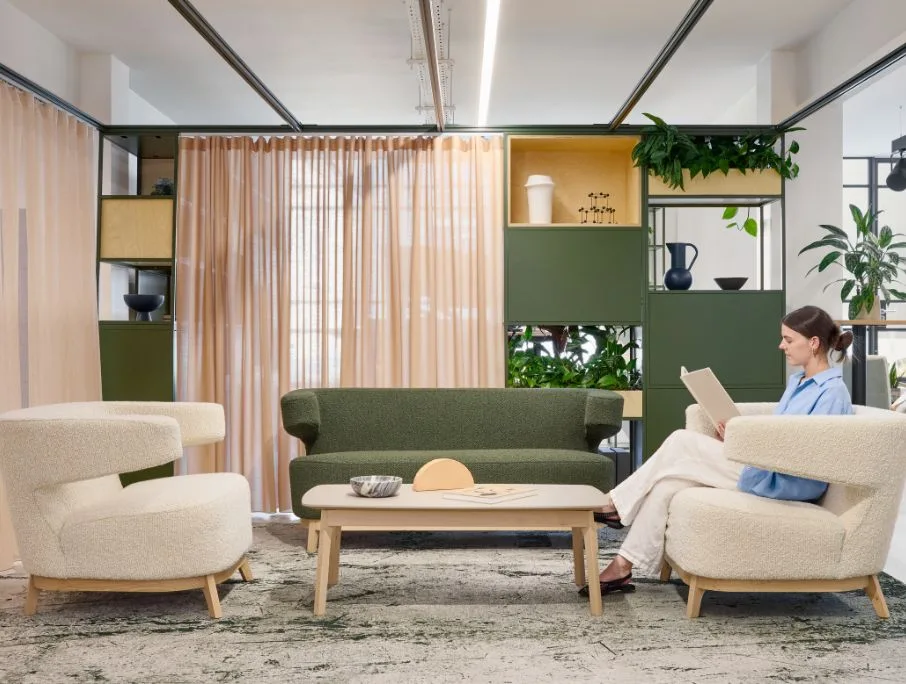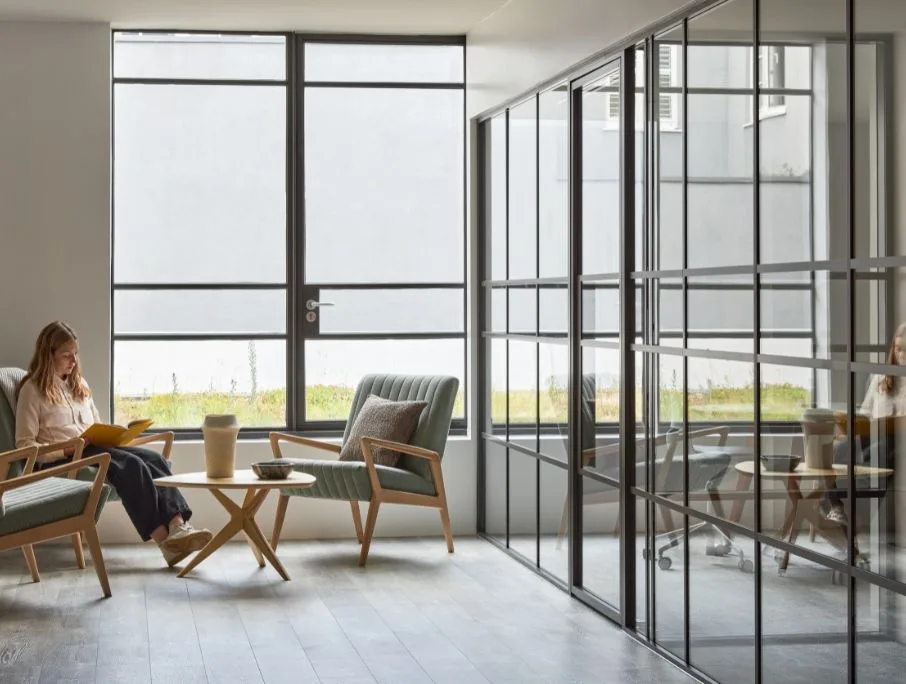What Is Modern Office Design? Ideas On Building Our Future Workspaces
How does today’s office space look different to yesterday’s? And how will tomorrow’s work environment differ again?
As the workplace evolves, so must its spaces. We’re not simply talking colour palettes and fabric swatches here. Today’s workspace interior design focuses on how design elements change the way people feel, perform and interact.
In 2025, forward-thinking businesses are creating environments that support wellbeing, inclusivity, adaptability, and flexible working. There’s a firm focus on sustainability, connectivity and technology.
Here, we’ll explore the core elements shaping modern office design in 2025. We’ll consider why they matter to organisations looking to attract talent, boost productivity and reflect their brand values.

A brief evolution of office design
Back in the 1970s, it was all about hierarchy. People aimed to get their own private office as a mark of corporate status. And their doors were kept closed. In the 1980s, cost-cutting measures meant optimising space. Cubicles became the thing, cramming in more people to an office layout.
The ‘dot-com boom’ of the 1990s made technology more important, along with collaboration. Open plan offices started to spring up. These open office environments evolved over the next few years, with hot-desking and flexible working rising in popularity.
But hybrid and remote work really took hold in the pandemic years of 2020 and soon after. Suddenly people were thrust into working from their living rooms with a laptop perched on their knees. With that came a stronger focus on people’s health – both physical and mental – and how that’s impacted by the work environment. Office spaces now, are being reimagined as collaborative, inclusive hubs. As our homes become workspaces, our offices need to offer something more.

What elements should be considered in modern office space design?
Today’s office interior design prioritises people and planet. Health and wellbeing’s a crucial consideration. As the work culture’s become less structured and formal, so has the office environment. Workplace design is more fluid and flexible than ever before.
1. Wellbeing
Our mental and physical health is high on the workplace agenda. It’s a non-negotiable for responsible employers. But how is that reflected in our office buildings?
Offices designed for employee wellbeing prioritise:
- Biophilic design: Abundant natural light, indoor plants, natural materials and textures are important aspects. These help to reduce stress and elevate mood. They can improve the air quality. The bring in positive benefits of the outdoors to the indoor office environment.
- Ergonomic furniture: Forget rigid, uniform chairs and desks. Now you’re encouraged to adjust your furniture to suit you. Improve your posture and reduce time spent seated with sit-stand desks and ergonomic seating
- Acoustic features: Open spaces can be noisy and distracting. Increasingly, soundproof pods and work areas are being created for noise-sensitive tasks. It gives people the option of working in a quieter area if and when they need to.
- Dedicated wellness zones: Quiet rooms, meditation areas, on-site gyms or outdoor zones for mindful breaks all help workers to reset and press pause on their busy workday.
2. Inclusivity
A truly modern workspace caters to a diverse workforce. Care and consideration needs to be made when designing your work areas to ensure they caters for myriad needs.
Sensory considerations are crucial to enable neurodivergent employees to thrive. Aspects including varied lighting, soundproof zones, muted colour palettes and flexible layouts will make a positive difference.
Accessible design ensures that workspaces are equipped for physical and cognitive accessibility. This includes wheelchair-accessible layouts, adjustable desks and clear signage for navigation. Flexible furniture and layouts help to meet the wide-ranging needs of your workforce. Staying agile and adaptable will make your business more appealing to a diversity of talent.
3. Adaptability
One-size-fits-all doesn’t fit anymore. Today, it’s all about fluidity. As needs or circumstances change, so can the dynamics of your office space.
Static walls and furniture are yesterday’s news. The new office environment is multifunctional and reconfigurable. Think modular furniture, movable partitions and multi-use zones. These allow spaces to transform in minutes.
Why have a corporate meeting space that’s only used for formal board meetings? It’s left empty most of the time. With flexible furniture, it can be transformed dynamic workspaces with a series of dividers to create specific zones.
Different work styles and tasks lend themselves to different spaces. Fluid workspaces blend private booths with breakout areas or collaboration zones to support teamwork or independent focus time.
4. Flexibility
Work’s no longer tied to a desk in an office. With the ability to work remotely from your home office, a co-working space or your kitchen table, why commute to an office building?
Office spaces need to serve a different function – as a hub of connection. Now, they must cater to the needs of in-office, remote and hybrid teams. So that means shared workstations, drop-in rooms, and smart booking systems rather than set, permanent desks.
5. Sustainability
Future-thinking organisations prioritise our fragile environment and their impact upon it. Environmentally-friendly materials and sustainable practices must be a core part of office interior design.
Consciously choosing materials with low environmental impact is a must. That would include recycled plastic or timber, low-VOC paints, responsibly-sourced and local materials for example.
6. Smart technology
Technology’s at the heart of today’s workspace. On the one hand, it aids workplace productivity and connectivity. But it also supports our office environment. Both impact our daily working lives.
Smart building systems help to optimise the environment. That includes automated lighting and HVAC sensors for starters. The right design choices here can make your space more energy-efficient and also support your employees’ wellbeing.
It’s also crucial to have reliable, speedy, tech-enabled connectivity. Every work station demands it. Every AV-equipped meeting rooms needs it. Even your entry systems and communal spaces require smart technology.

Case study: Societe Generale
When Société Générale relocated to a new office building in Canary Wharf, they took their time to design the best working environment for their teams.
The result combined elegant interior design and open, flexible working environments flooded with natural light and panoramic views over the city. Alongside workstations, alternative workspaces such as breakout areas, meeting rooms and individual booths were integrated. A neutral colour palette, and natural materials, added aspects of biophilic design to the space.
Create your modern workspace with KI Furniture
If you’re going to lure people away from the convenience of working from home, your office space needs to offer something special. Modern offices are forward-focused and prioritise their people’s needs and wellbeing, as well as those of our planet.
From ergonomic furniture and flexible office layouts to sustainable practices and inclusive environments, workplace design must reflect diverse needs.
We’re passionate about creating future-focused, flexible and inclusive environments. As an innovative and creative team, we’re constantly learning and redefining workspaces. Please get in touch to discuss your specific needs and workplace ideas.
